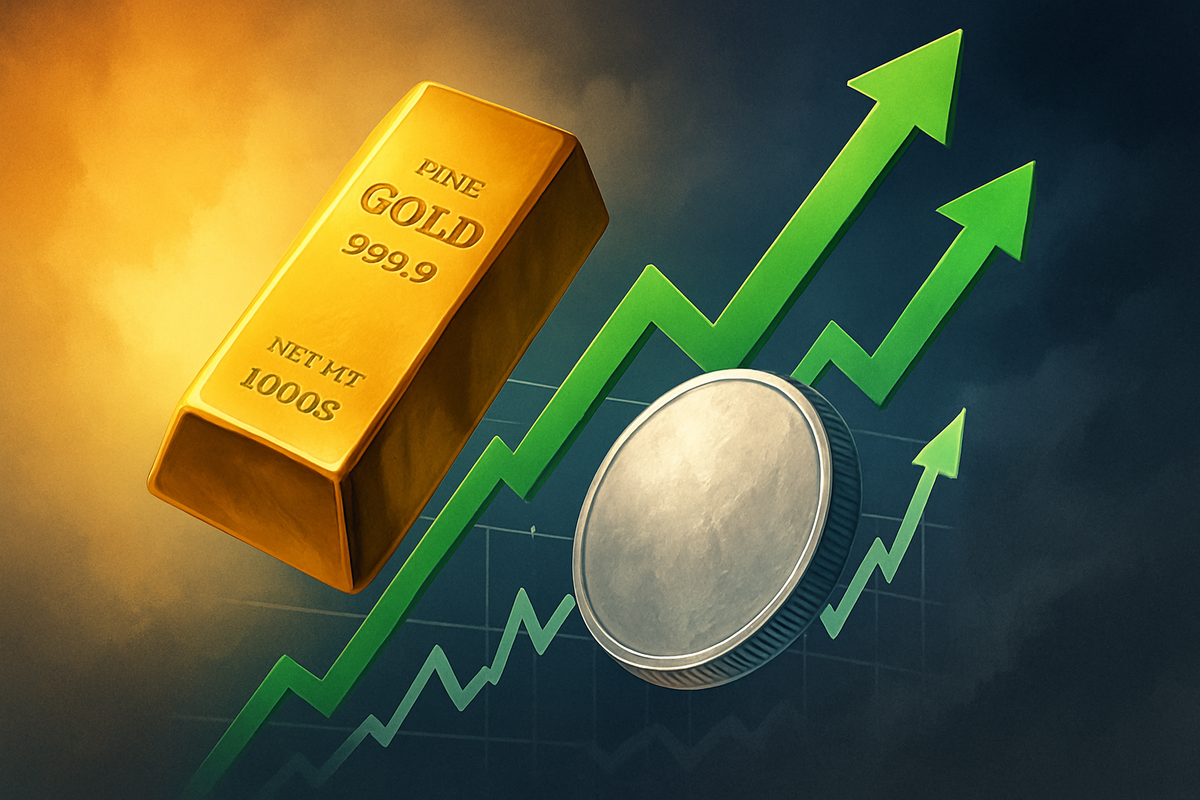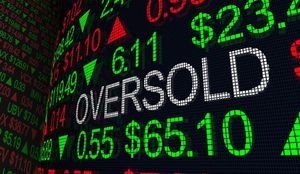
The global financial landscape is currently presenting a perplexing and unprecedented scenario: on October 8, 2025, gold, silver, and major U.S. stock indices have all simultaneously soared to record highs. This unusual synchronicity in traditionally divergent assets—precious metals often seen as safe havens during uncertainty, and equities as indicators of economic confidence—is sending mixed signals across the market. While some interpret it as a testament to abundant liquidity and diverse investor confidence, others are raising alarms about the potential for a "blow-off top" in the stock market, hinting at an impending reversal. This peculiar market behavior reflects a deep lack of confidence in traditional financial systems and governmental efficacy, prompting a collective reappraisal of what constitutes a "safe" asset, even as investors chase growth.
Unpacking the Simultaneous Ascent: Details, Drivers, and Reactions
The simultaneous ascent of gold, silver, and the S&P 500 (NYSEARCA: SPY) (representing U.S. stocks) on October 8, 2025, marks a remarkable moment in financial history, signaling a market flush with liquidity but also grappling with contradictory forces. Gold, long considered the ultimate safe-haven asset, surged past the $4,000 per ounce mark, hitting $4,049.56 per ounce for its 40th record high this year, with December delivery futures reaching an all-time best of $4,072 per ounce. Silver, mirroring gold's rally, climbed as much as 3.4% to $49.55 per ounce, surpassing its previous record from 1980. Concurrently, U.S. stock markets continued their upward trajectory, with major indices reaching new peaks.
The timeline leading up to this moment has been characterized by a "toxic cocktail of pressures" driving precious metals higher, even as equities defied gravity. Geopolitical and economic uncertainties, including rising global political turbulence and concerns over U.S. fiscal stability (such as a prolonged U.S. government shutdown), have fueled safe-haven demand. Expectations of U.S. interest rate cuts, a weakening U.S. dollar, strong central bank buying, and significant inflows into gold-backed exchange-traded funds have provided substantial support for bullion. Silver, in addition to its safe-haven appeal, has benefited from robust industrial demand, particularly from the booming solar panel and electric vehicle sectors, coupled with persistent supply deficits.
Initial market reactions are mixed, reflecting the inherent paradox of the situation. While some investors celebrate the broad-based market strength, others are expressing caution. Analysts are highlighting that this concurrent rally suggests investors are simultaneously seeking both growth opportunities in stocks and protection against perceived risks in precious metals. This implies a market environment where participants are hedging against potential instability even as they participate in speculative rallies, creating a delicate balance that could easily tip.
Corporate Fortunes in a Dual-High Market: Winners and Losers
In this unique market environment where both speculative assets and safe havens are thriving, the impact on public companies is multifaceted, creating distinct winners and potential losers across various sectors.
Mining companies, particularly those focused on precious metals, stand to be significant beneficiaries. Companies like Barrick Gold (NYSE: GOLD), Newmont (NYSE: NEM), and Wheaton Precious Metals (NYSE: WPM) are seeing their revenue and profit margins swell due to the record-high prices of gold and silver. These elevated commodity prices provide a strong tailwind for their operations, potentially leading to increased exploration budgets, higher dividends, and stronger balance sheets. Silver miners, such as Pan American Silver (NASDAQ: PAAS) and First Majestic Silver (NYSE: AG), are also experiencing a boom, driven by both investment demand and growing industrial applications in green technologies.
Conversely, companies heavily reliant on consumer discretionary spending or those with high input costs for precious metals might face challenges. While a strong stock market generally indicates robust economic activity, the underlying reasons for the precious metals rally—geopolitical uncertainty and inflation concerns—could erode consumer confidence or increase operational expenses for certain industries. Furthermore, companies in sectors that are particularly sensitive to interest rate hikes, if the Federal Reserve were to pivot unexpectedly, could see their valuations suffer, especially if the current stock market highs are indeed a "blow-off top."
Technology and growth stocks, which have largely driven the equity market's ascent, may continue to perform well in the short term, especially if liquidity remains abundant. However, their stretched valuations, as indicated by metrics like the "Buffett indicator," make them particularly vulnerable if market sentiment shifts rapidly. Investors might begin to rotate out of these high-flying assets into more defensive sectors or back into cash if the "blow-off top" scenario materializes, leading to significant corrections for companies that have seen exponential growth without commensurate earnings.
Wider Significance: Euphoria, Uncertainty, and Historical Echoes
The simultaneous record highs across gold, silver, and U.S. stocks represent a phenomenon of profound wider significance, hinting at a market caught between euphoric speculation and deep-seated uncertainty. This event fits into broader industry trends where investors are navigating a landscape of persistent inflation concerns, geopolitical instability, and a search for yield in a world awash with liquidity. The traditional inverse correlation between equities and safe-haven assets has seemingly broken down, suggesting a market where participants are hedging against perceived risks even as they chase growth.
Potential ripple effects on competitors and partners are considerable. In the precious metals sector, the surge in prices could incentivize increased production and exploration, potentially leading to a supply response in the long term, which might temper future price gains. For industries that utilize silver, such as solar panel manufacturers or electronics companies, the elevated prices could increase input costs, potentially affecting profit margins or leading to price adjustments for end consumers. In the equity markets, if the "blow-off top" scenario unfolds, it could trigger a significant repricing of assets across the board, impacting everything from venture capital funding to corporate mergers and acquisitions.
Regulatory or policy implications are also noteworthy. Central banks, particularly the U.S. Federal Reserve, will be closely watching this development. The simultaneous highs could be interpreted as a sign of overheating markets, potentially prompting policymakers to consider tighter monetary conditions sooner than anticipated, or to address underlying fiscal stability concerns. Conversely, if the precious metals rally is primarily driven by a lack of confidence in fiat currencies, it could put pressure on governments to demonstrate greater fiscal prudence.
Historically, periods of extreme market euphoria, often characterized by rapid asset price appreciation across multiple classes, have frequently preceded significant market corrections. One market strategist has drawn comparisons to the 2007 market, where gold, silver, and platinum miners rocketed higher while the broader stock market began to stall, signaling a "last kind of wave" before a significant reversal. The "Buffett indicator," which measures total U.S. market cap to gross national product, has surged past 200%, a level historically associated with "irrational exuberance" and overvalued equities, reinforcing concerns about stretched valuations and the possibility of a "blow-off top."
What Comes Next: Navigating a Precarious Balance
The current market dynamic of simultaneous record highs in gold, silver, and U.S. stocks sets the stage for a period of heightened volatility and potential strategic shifts. In the short term, the market could continue its upward momentum, fueled by existing liquidity and investor exuberance. However, the underlying tensions suggest that this precarious balance is unlikely to last indefinitely. A critical trigger, such as an unexpected shift in monetary policy, a significant geopolitical event, or a sudden loss of confidence, could easily initiate a sharp reversal, particularly in the overextended equity markets.
For investors and companies, strategic pivots and adaptations will be crucial. Businesses with exposure to precious metals may consider locking in profits or expanding production where feasible, while those with significant equity holdings might re-evaluate their risk exposure and consider hedging strategies. Market opportunities could emerge in defensive sectors, value stocks, or alternative assets if a correction materializes. Conversely, significant challenges will arise for companies with high debt levels or those heavily reliant on sustained market growth, as a downturn could severely impact their access to capital and operational viability.
Potential scenarios and outcomes range from a continued "melt-up" followed by a sharp correction (the "blow-off top" scenario) to a more gradual rebalancing as investors rotate out of overvalued assets. Another possibility is a prolonged period of elevated volatility where both safe havens and risk assets remain strong but subject to rapid fluctuations, reflecting ongoing uncertainty. The key will be to discern whether the current strength is a sign of robust economic fundamentals or merely a symptom of excessive liquidity chasing limited opportunities, ultimately leading to unsustainable valuations.
Comprehensive Wrap-Up: A Market at a Crossroads
The unprecedented simultaneous record highs across gold, silver, and U.S. stocks on October 8, 2025, represent a pivotal moment for global financial markets. The key takeaway is the inherent contradiction: investors are simultaneously seeking growth in equities and protection in precious metals, signaling a deep-seated uncertainty beneath the surface of market exuberance. This phenomenon is largely driven by abundant liquidity, geopolitical instability, expectations of interest rate adjustments, and concerns over fiscal stability, all contributing to a complex and potentially volatile environment.
Moving forward, the market faces a critical juncture. While the current strength might appear robust, the historical context and stretched valuations in the equity market, as highlighted by indicators like the "Buffett indicator," suggest the possibility of a "blow-off top." This scenario would involve a rapid and euphoric final surge in stock prices, followed by a sharp and sudden collapse. The concurrent rally in safe-haven assets like gold and silver, traditionally inverse to stock market performance, further underscores the fragility of the current market structure.
Investors should remain vigilant and exercise caution. It is crucial to monitor key economic indicators, central bank communications, and geopolitical developments. Diversification, risk management, and a clear understanding of one's investment objectives will be paramount. While the allure of rising asset prices is strong, the current confluence of factors suggests that the market is operating on a precarious balance. The coming months will likely reveal whether this dual-high phenomenon is a harbinger of sustained economic strength or a precursor to a significant market correction, making prudent decision-making more important than ever.
This content is intended for informational purposes only and is not financial advice







